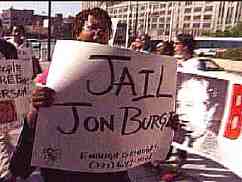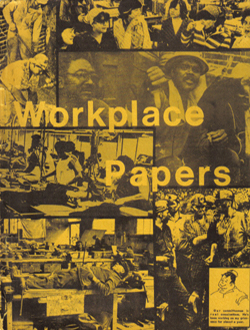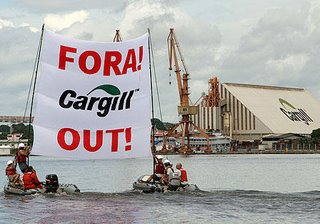
Earlier this year, Human Watch Rights reported, "The estimated 8.8 million largely South and Southeast Asian and Arab foreign workers in Saudi Arabia comprise a third of the country's population, according to Minister of Labor Ghazi al-Gosaibi. Many face exploitative working conditions, including sixteen-hour workdays, no breaks or food and drink, and often remain confined to locked dormitories during their time off. Security forces deported tens of thousands of illegal immigrants in 2005. Arrested foreign workers face torture and prolonged incommunicado detention."
While several hundred Filipinos being held in Saudi jails were recently granted a pardon by the King, hundreds, if not thousands, more remained locked up in stinking conditions in jails across the middle east.
The following is from Bulatlat.
A tale from a Saudi jail
‘Para Kaming mga Baboy’ (We Were Like Pigs)Joelito Lesma, one of a group of 12 OFWs currently confined in their employer’s quarters and set to be transferred to a Saudi jail, did not wait for President Gloria Macapagal-Arroyo to visit the Kingdom of Saudi Arabia and ask King Abdullah to have him pardoned. He found his own way to escape the kingdom. BY AUBREY SC MAKILAN
Joelito Lesma did not wait for President Gloria Macapagal-Arroyo to visit the Kingdom of Saudi Arabia and ask King Abdullah to have him pardoned.
He found his own way to escape the kingdom.
“Mas nagtagal siguro ang hirap ko doon kung lumapit ako sa kanila (referring to Philippine embassy officials),” he said. (My hardships could have lasted longer if I asked them to help in my case.)
Like pigsLesma was one of 12 Overseas Filipino Workers (OFWs) who ran away from and subsequently charged their employer before a Jeddah court in January 2006 for contract substitution, non-payment of salaries and benefits, non-issuance of official receipts of payment, and illegal termination. His companions were Estanislao Madayag Jr, Mouriel Depra, Jerry Dianala, Levy Defino, Allan Malate, Jason Paano, Eduardo De Silva, Harrison Suguitan, Ariel Cordova, Jerry Padua, and Joel Poliwas.
In April, the court ruled in favor of their employer. The 12 OFWs were ordered to pay 5,564 Saudi riyals each to their employer.
Lesma escaped from the barracks of their employer where they were initially held.
He paid a Filipino-Muslim to bring him to a “safehouse” where other run-away workers were waiting to be arrested by the Saudi police. They were later brought to a Jeddah jail called Jawazat where he stayed for almost a month.
“Kahit na may umaalis, araw-araw libo-libo ang pumapasok,” narrated Lesma, “Para kaming nasa kulungan ng baboy.” (When people leave the jail, thousands more replace them. We felt like being in a pig sty.)
Each cell could contain a thousand, Lesma said, but there were too many prisoners that we sometimes step on one another. “Marumi, malamig ang sementong hinihigaan namin. ‘Yung karton na pwede mong isapin sa likod, minamana sa mga umaalis. Pero dahil sa liit, paggising mo sa umaga, nasa semento ka na rin,” (The cement floor where we lied down to sleep was dirty and cold. The piece of box we used to lie down on was given by fellow prisoners who were released earlier. But the piece of box was too small that when you woke up in the morning, you almost always ended up on the cement floor.) he recalled.
He only had one pair of pants, two underwears and two T-shirts. “’Pag hinubad mo ‘yung pantaloon mo, tatayo mag-isa ‘yun mamaya,” (If you removed your pants, it was so stiff with dirt that it could stand on its own.) he said, adding that others would steal your clothes once you removed them.
Even if there was sufficient food, it was not properly given to them, he said. They were fed at 10 a.m., 4 p.m., and 10 p.m.
“Iiwan lang ng mga pulis sa gitna ‘yung malalaking lalagyan ng kanin at ulam tapos hahayaan na nilang magkagulo kami. Walang disiplina. ‘Yung iba nga, yung natatapon na lang sa sahig ang kinukuha para makakain. Parang pagkain ng baboy,” (The police leaves the big containers of rice and viands at the middle of the cell and lets us grab our food. There was no discipline. Others just eat the food that spills on the floor. It is just like feeding pigs.) said Lesma.
Because of their condition, Lesma told Bulatlat most of them had colds, fever, and cough.
“Sa halos isang buwan akong nandon, isang beses ko lang nakitang nagdala ng gamot ang (Philippine) embassy sa amin,” he lamented, “Para makainom kami ng gamot, magpapabili pa kami. Eh pa’no ‘yung mga walang pera?” (In the almost one month I was there, Philippine embassy personnel brought us medicine just once. To be able to drink the medicine you need, you have to ask people to buy it for you at your own expense. If you don’t have money, what will happen to you?)
BackdoorWhile in jail, Lesma contacted a person who helped him process his papers. He identified this person as an embassy employee who can get you out of the kingdom through the backdoor.
He said that he was asked to fill out two forms. On one form he was asked to supply his personal information for the embassy’s record. For the other form, he used an assumed Muslim name to facilitate his escape.
“Mas madali kung wala kang mga dalang papeles,” said Lesma, “’Di na ako humingi ng tulong sa embassy dahil sa natalo na kami, matatagalan pa ang kaso namin sa kanila.” (It is easier if you had no personal papers on you. I did not ask help from the embassy because we already lost our case and it will take longer to have them facilitate our release.)
He said they were asked to tell the authorities they were there for ‘Umbra’ or Lesser Pilgrimage so that they will be charged only for overstaying.
Lesma was able to return to the Philippines through the backdoor under the new name of Ali Ibrahim.
He promised he would not leave again if the destination is the Kingdom of Saudi Arabia.
“Kung sana kasya ang kinikita ko dito, hindi ko naman gustong iwan ang asawa at tatlong anak ko,” (If only I was earning enough, I never wanted to leave my wife and three children.) he said.
More are strandedThe families of abused and stranded OFWs in Saudi Arabia called on the government to help in the repatriation of their relatives.
Upon her arrival from a four-day state visit in the Kingdom of Saudi Arabia, May 11, President Gloria Macapagal-Arroyo announced that she was able to convince King Abdullah to pardon 700 OFWs languishing in Saudi jails. On May 12, 170 repatriated OFWs arrived in Manila from Jeddah.
“What about the others left behind?” asked Migrante International and the families of stranded Filipino migrant workers.
Maita Santiago, Migrante International Secretary-General said that the 11 OFW companions of Lesma would be transferred from the barracks of their employer, where they are currently confined, to a jail in Alkhobar, Saudi, Arabia if they would not be able to pay their employer the 5,564 Saudi riyals fine imposed by the court on each of them by May 12. As of press time, Migrante International has not yet received word regarding the fate of the 11 OFWs.
“Hihintayin pa ba nilang makulong ang mga ‘yun bago sila umaksyon?” (Will the government wait until the 11 are imprisoned before acting on their case?) asked De Silva ‘s wife Lani, who was teary-eyed during the interview with Bulatlat.
The OFWs and their families do not have enough money to pay the fine. Lani said that they were told by officials of the Overseas Workers Welfare Administration (OWWA) that the government has no fund to pay the employer.
Lani said that her husband cries over the phone every time he shares the hardships they endure. “Isang beses na lang daw sila kumakain sa isang araw,” (They only eat once a day.) said Lani.
“Hindi pa nga ako ulit nakakatawag mula nung May 8 dahil naaawa akong marinig ’yung mga kwento nila,” (I haven’t called him since our last conversation May 8 because my heart breaks when I hear their stories.) she said.
Lani also complained that the DFA supplied the 11 with food only three times during the four months that they were confined at the employer’s quarters. She added that the DFA even delivered expired food once.
“Wala ring malinaw na sinasabi ang gobyerno sa kaso nila,” she said, “Hihintayin pa ba nila ang susunod na amnesty? Kelan, ‘pag patay na sila?” (The government does not give us a clear response regarding the case of the 11 OFWs. Will the government still wait for another amnesty? Until when will the government wait? When the 11 are already dead?)
Lani complained that her husband is suffering from frequent attacks of asthma and sinusitis. Michel, wife of Madayag Jr., is worried about her husband’s rising blood pressure.
More OFWs in distress“The case of the 11 is just an example of the urgent plight that many Filipino migrants and their families still face,” said Santiago. “Mrs. Arroyo’s so-called ‘pasalubong’ (take home offering) of even around 300 OFWs repatriated clearly falls short of our expectations. While its good some are coming home- this publicity gimmick says nothing about the situation of the many more left behind,” said Santiago in a statement.
According to a DFA 2004 report, there are around 1,841 Filipino migrants detained or imprisoned across the Middle East while 4,429, largely women, are in Philippine government shelters across the region. There are approximately 820,000 OFWs in Saudi Arabia with many of the women working as domestic or household workers, numbering around 148,500 while the 318,500 men work as production and construction workers, the report also said.
Migrante is currently handling two other cases, that of abused Filipina OFWs Jinalyn Rejano and Editha Orea.
Jinalyn was raped on February 14 by seven men (her employer, his family and a staff member at her recruitment agency) while Editha was also abused by her employer. Although both are now at a Philippine government run shelter, their efforts to obtain justice against their Saudi Arabian employers are dimming.
”Nangako ang DFA at OWWA na ilalaban ang kaso. Pero nung na-dismiss na e pauwiin na lang daw si Jinalyn. Sa dami ng nabibiktima ang iba ay walang lakas loob na ilaban ang kaso kaya tinatago na lang ang nangyari. Pero si Jinalyn gusto niyang habulin ang mga nagkasala sa kanya. Marami pang kaso ng rape pero sa tingin nila hindi nila kaya lumaban kaya nananahimik na lang. Sana bigyan ng gobyerno ng pansin ang mga kaso at hindi puro drawing. Gusto sana naming magkasama-sama na. Okay lang na sa ngayon ay magkalayu-layo pa kami basta mabigyan ng hustisya,” (The DFA and OWWA promised that they would pursue the case. But when Jinalyn’s case was dismissed, they told me to just ask Jinalyn to come home. But Jinalyn insisted that she wanted to obtain justice by having her rapists punished. There are a lot of cases of rape of OFWs but some chose to keep silent because they felt that they had no means to pursue the case. We hope that the government will be serious in pursuing the cases and is not out only to put up a show. While we want her to come home soonest to be together. It is okay that we are still temporarily separated for as long as we obtain justice.) said Elmer Rejano, her husband.
Long term solutionMeanwhile, Migrante International chairperson Connie Bragas-Regalado said the president’s “photo-opportunities in Saudi Arabia will do little to genuinely alleviate the plight of Filipino migrant workers in the Kingdom.”
Bragas-Regalado said among the urgent issues the president should be taking up with King Abdullah are: “the cases of OFWs on death row; the Unified Contract, which essentially legitimizes contract substitution; the formation of a shelter for male OFWs, which is currently not allowed by Saudi Arabian laws; and the right of OFWs to leave the country whenever they desire. Currently, OFWs without exit visas granted by their employer are prevented from leaving the country.”
“Particular to the OFWs in jail, there should also be an independent investigation as to how legal funds for OFWs are used by the Department of Foreign Affairs,” she added.
Citing the Migrant Workers Act of 1995, Bragas-Regalado said that P100 million is supposed to be allotted by the government annually to help OFWs who get into trouble with the law. The money is given to the Legal Assistant for Migrant Affairs, which is under the DFA. In a recent report to the House of Representatives, the DFA said more than 4,700 OFWs were languishing in jails in various countries.
”In the long-run, the best interests of Filipino migrants are served if instead of exporting workers, the Philippine government genuinely implements policies that create viable livelihood opportunities for its people in the county,” she said.


















